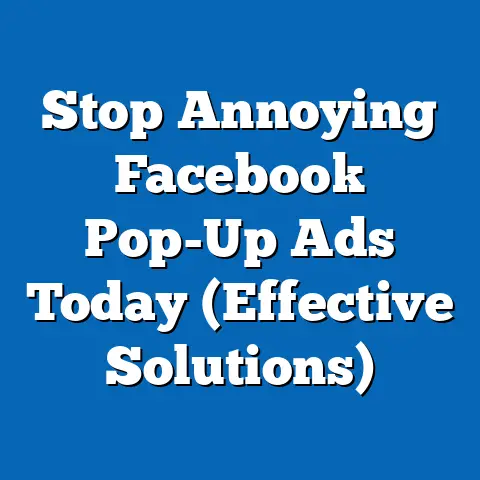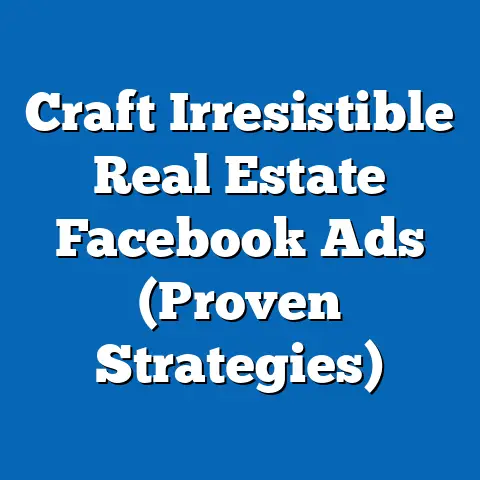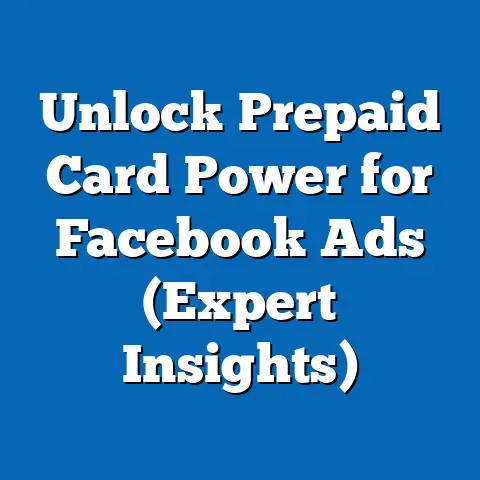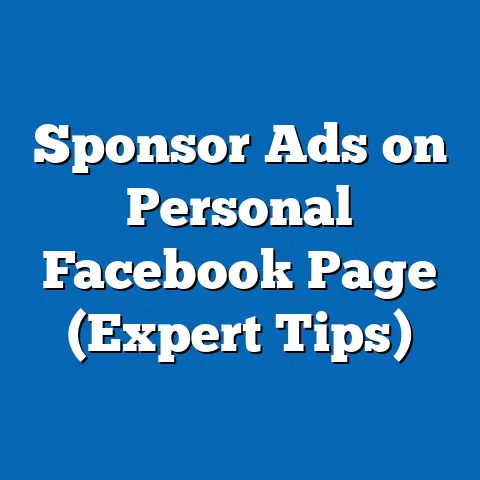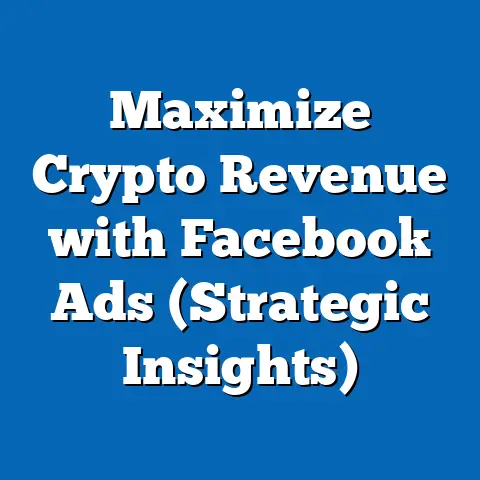Maximize Facebook Ad Success (Proven Strategies)
Maximize Facebook Ad Success: Proven Strategies
Facebook advertising is a powerhouse for businesses of all sizes. With billions of active users, the platform offers unparalleled reach and targeting capabilities. However, simply throwing money at Facebook Ads isn’t enough. To truly succeed, you need a strategic approach, a deep understanding of your audience, and a commitment to continuous optimization. Let’s embark on a journey to transform your Facebook ad campaigns from expenses to strategic investments.
The Strategic Imperative of Facebook Ad Investment
Investing in Facebook advertising is not just about spending money; it’s about strategically allocating resources to achieve specific business objectives. I’ve seen firsthand how businesses that treat their ad spend as a strategic investment consistently outperform those that don’t.
Consider this: a local bakery I worked with initially hesitated to invest heavily in Facebook Ads. They saw it as an added cost. However, after implementing a targeted campaign that showcased their artisanal bread and pastries to local food enthusiasts, their weekend sales skyrocketed. The cost of the ads was quickly overshadowed by the increase in revenue, proving that a well-executed Facebook ad strategy can indeed be a lucrative investment.
The Potential ROI of Facebook Ads
The potential ROI from Facebook Ads is immense, but it requires a well-thought-out plan. According to recent statistics, businesses can see an average return of $8 for every $1 spent on Facebook advertising. This impressive figure underscores the potential impact of a strategic approach.
The Competitive Edge
In today’s digital landscape, competition is fierce. Businesses that commit financially to Facebook Ads often gain a significant advantage over their competitors. By strategically allocating resources, they can reach a wider audience, build brand awareness, and drive conversions more effectively.
Key Takeaway: Treat your Facebook ad spend as a strategic investment rather than an expense. This mindset shift will drive you to optimize your campaigns for maximum ROI, ensuring that every dollar spent contributes to your business goals.
Section 1: Understanding Your Audience
Before even thinking about ad creatives or bidding strategies, I always start with a deep dive into understanding my audience. This is where the magic truly begins. Facebook offers an array of powerful targeting tools, but they’re only effective if you know who you’re trying to reach.
The Necessity of Identifying Your Target Audience
I can’t stress this enough: Knowing your audience is the cornerstone of any successful Facebook ad campaign. It’s not enough to simply guess who might be interested in your product or service. You need concrete data and insights to guide your targeting efforts.
Facebook’s Audience Targeting Tools
Facebook provides a suite of sophisticated targeting tools that allow you to reach specific demographics, interests, and behaviors. Here’s a breakdown:
-
Custom Audiences: These are created using your existing customer data, such as email lists, phone numbers, or website visitors. I find this incredibly powerful because it allows you to reconnect with people who are already familiar with your brand.
- Example: I once uploaded a list of past customers to Facebook and created a Custom Audience. I then ran a special promotion targeted specifically at this group, resulting in a 20% increase in repeat business.
-
Lookalike Audiences: This feature allows you to find new people who are similar to your best customers. Facebook analyzes the characteristics of your Custom Audience and identifies users who share those traits.
-
Example: I created a Lookalike Audience based on my top-spending customers. This resulted in a significant increase in high-value leads and a lower cost per acquisition.
-
Interest-Based Targeting: This lets you target users based on their interests, hobbies, and pages they’ve liked on Facebook.
-
Example: If you’re selling fitness equipment, you can target users who have expressed interest in fitness, health, and wellness.
Custom Audiences: These are created using your existing customer data, such as email lists, phone numbers, or website visitors. I find this incredibly powerful because it allows you to reconnect with people who are already familiar with your brand.
- Example: I once uploaded a list of past customers to Facebook and created a Custom Audience. I then ran a special promotion targeted specifically at this group, resulting in a 20% increase in repeat business.
-
Lookalike Audiences: This feature allows you to find new people who are similar to your best customers. Facebook analyzes the characteristics of your Custom Audience and identifies users who share those traits.
-
Example: I created a Lookalike Audience based on my top-spending customers. This resulted in a significant increase in high-value leads and a lower cost per acquisition.
-
Interest-Based Targeting: This lets you target users based on their interests, hobbies, and pages they’ve liked on Facebook.
-
Example: If you’re selling fitness equipment, you can target users who have expressed interest in fitness, health, and wellness.
Lookalike Audiences: This feature allows you to find new people who are similar to your best customers. Facebook analyzes the characteristics of your Custom Audience and identifies users who share those traits.
Example: I created a Lookalike Audience based on my top-spending customers. This resulted in a significant increase in high-value leads and a lower cost per acquisition.
Interest-Based Targeting: This lets you target users based on their interests, hobbies, and pages they’ve liked on Facebook.
Example: If you’re selling fitness equipment, you can target users who have expressed interest in fitness, health, and wellness.
Creating Buyer Personas
Creating detailed buyer personas is a crucial step in understanding your audience. A buyer persona is a semi-fictional representation of your ideal customer, based on market research and data about your existing customers.
Key Elements of a Buyer Persona:
- Demographics: Age, gender, location, income, education, occupation.
- Psychographics: Interests, values, lifestyle, attitudes, and opinions.
- Pain Points: Challenges and frustrations that your product or service can solve.
- Goals: What your ideal customer hopes to achieve.
Utilizing Facebook Insights
Facebook Insights provides valuable data about your audience, including their demographics, interests, and behaviors. This information can help you refine your targeting and create more effective ads.
Tips for Segmenting Audiences
Segmenting your audience allows you to tailor your messaging for improved engagement. Here are some tips:
- Segment by Demographics: Create different ads for different age groups or genders.
- Segment by Interests: Target users based on their specific interests.
- Segment by Behavior: Target users based on their online behavior, such as purchasing habits.
Key Takeaway: Understanding your audience is paramount. Utilize Facebook’s targeting tools, create buyer personas, and leverage Facebook Insights to refine your targeting and improve ad performance.
Section 2: Crafting Compelling Ad Creative
Now that you know who you’re targeting, it’s time to create ad creatives that resonate with them. This is where creativity and data-driven insights meet. A compelling ad creative can capture attention, convey your message effectively, and drive conversions.
Elements of Effective Ad Creative
An effective ad creative typically includes the following elements:
- Visuals: High-quality images or videos that grab attention and convey your brand’s message.
- Headlines: Clear and concise headlines that highlight the value proposition of your product or service.
- Ad Copy: Engaging and persuasive text that encourages users to take action.
Aligning Ad Creatives with Brand Identity
It’s crucial that your ad creatives align with your brand identity. This means using consistent colors, fonts, and messaging across all of your ads. When I help clients with branding, I always emphasize the importance of maintaining a cohesive brand image to build trust and recognition.
Examples of High-Performing Ad Creatives
Let’s look at some examples of ad creatives that have performed well and analyze what makes them successful:
-
Example 1: A skincare brand used a before-and-after photo in their ad, showcasing the dramatic results of their product. The ad copy highlighted the key ingredients and benefits, and the call-to-action (CTA) was “Shop Now.”
- Why it worked: The visual was compelling, the value proposition was clear, and the CTA was direct.
-
Example 2: A travel agency used a stunning video of a tropical beach in their ad, accompanied by ad copy that evoked a sense of wanderlust. The CTA was “Book Your Dream Vacation.”
-
Why it worked: The visual was aspirational, the messaging was emotional, and the CTA was enticing.
-
Example 3: A SaaS company used a short demo video in their ad, showcasing the key features of their software. The ad copy highlighted the benefits of using the software, and the CTA was “Start Your Free Trial.”
-
Why it worked: The visual was informative, the value proposition was clear, and the CTA was low-risk.
Example 1: A skincare brand used a before-and-after photo in their ad, showcasing the dramatic results of their product. The ad copy highlighted the key ingredients and benefits, and the call-to-action (CTA) was “Shop Now.”
- Why it worked: The visual was compelling, the value proposition was clear, and the CTA was direct.
-
Example 2: A travel agency used a stunning video of a tropical beach in their ad, accompanied by ad copy that evoked a sense of wanderlust. The CTA was “Book Your Dream Vacation.”
-
Why it worked: The visual was aspirational, the messaging was emotional, and the CTA was enticing.
-
Example 3: A SaaS company used a short demo video in their ad, showcasing the key features of their software. The ad copy highlighted the benefits of using the software, and the CTA was “Start Your Free Trial.”
-
Why it worked: The visual was informative, the value proposition was clear, and the CTA was low-risk.
Example 2: A travel agency used a stunning video of a tropical beach in their ad, accompanied by ad copy that evoked a sense of wanderlust. The CTA was “Book Your Dream Vacation.”
Why it worked: The visual was aspirational, the messaging was emotional, and the CTA was enticing.
Example 3: A SaaS company used a short demo video in their ad, showcasing the key features of their software. The ad copy highlighted the benefits of using the software, and the CTA was “Start Your Free Trial.”
Why it worked: The visual was informative, the value proposition was clear, and the CTA was low-risk.
A/B Testing Different Creatives
A/B testing involves creating multiple versions of your ad and testing them against each other to see which performs best. This is a crucial step in optimizing your ad creatives.
Tips for A/B Testing:
- Test One Element at a Time: This allows you to isolate the impact of each element and determine what works best.
- Use a Control Group: This is the original version of your ad, which you’ll compare against the variations.
- Track Your Results: Monitor key metrics such as CTR, conversion rate, and cost per acquisition to determine which version performs best.
Key Takeaway: Crafting compelling ad creatives is essential for capturing attention and driving conversions. Align your creatives with your brand identity, analyze successful examples, and use A/B testing to optimize performance.
Section 3: Utilizing Facebook Ad Formats
Facebook offers a variety of ad formats, each with its own strengths and weaknesses. Understanding these formats and knowing when to use them is crucial for maximizing your ad success.
Different Ad Formats Available on Facebook
Here’s a rundown of the most common ad formats:
- Image Ads: These are simple ads that consist of a single image and ad copy. They’re great for showcasing products or services in a visually appealing way.
- Video Ads: These ads use video to capture attention and convey your message. They’re highly engaging and can be used to tell stories, demonstrate products, or share testimonials.
- Carousel Ads: These ads allow you to showcase multiple images or videos in a single ad unit. They’re great for highlighting different features of a product or service.
- Slideshow Ads: These ads combine multiple images into a slideshow format. They’re a cost-effective way to create video-like ads.
- Collection Ads: These ads are designed for e-commerce businesses. They allow you to showcase a collection of products in a visually appealing way.
Strengths of Each Format
- Image Ads: Simple, cost-effective, and great for showcasing products or services.
- Video Ads: Highly engaging, can be used to tell stories, and demonstrate products.
- Carousel Ads: Allow you to showcase multiple products or features in a single ad.
- Slideshow Ads: Cost-effective way to create video-like ads.
- Collection Ads: Designed for e-commerce businesses, allowing you to showcase a collection of products.
Guidance on Which Formats to Use
The best ad format for your campaign will depend on your goals and audience. Here are some general guidelines:
- Brand Awareness: Use video ads or slideshow ads to tell your brand’s story and capture attention.
- Lead Generation: Use image ads or carousel ads to showcase your lead magnet and encourage users to sign up.
- Conversions: Use collection ads or carousel ads to showcase your products and drive sales.
Facebook’s Ad Placement Options
Facebook offers several ad placement options, including:
- Facebook Feed: This is the most common placement and is great for reaching a broad audience.
- Instagram Feed: This placement is ideal for visually appealing ads and reaching a younger audience.
- Messenger: This placement allows you to reach users directly in their Messenger inbox.
Tips on Using Ad Placement Options Effectively
- Test Different Placements: See which placements perform best for your target audience.
- Tailor Your Creatives: Create different ad creatives for different placements.
- Monitor Your Results: Track your metrics and adjust your placements based on performance data.
Key Takeaway: Understanding the different ad formats and placement options available on Facebook is crucial for maximizing your ad success. Choose the formats that align with your goals and audience, and test different placements to optimize performance.
Section 4: Setting Goals and KPIs
Setting clear, measurable goals and identifying the right Key Performance Indicators (KPIs) is essential for tracking the success of your Facebook ad campaigns. Without clear goals, it’s impossible to determine whether your ads are actually working.
Importance of Setting Clear, Measurable Goals
I always tell my clients that setting goals is like setting a destination on a GPS. Without a destination, you’re just driving around aimlessly. The same is true for Facebook Ads.
Common KPIs to Track
Here are some common KPIs that businesses should track:
- Click-Through Rate (CTR): This is the percentage of people who click on your ad after seeing it. A high CTR indicates that your ad is relevant and engaging.
- Cost Per Click (CPC): This is the amount you pay each time someone clicks on your ad. A low CPC indicates that your ad is cost-effective.
- Conversion Rate: This is the percentage of people who take a desired action after clicking on your ad, such as making a purchase or filling out a form. A high conversion rate indicates that your ad is effective at driving conversions.
- Cost Per Acquisition (CPA): This is the amount you pay for each conversion. A low CPA indicates that your ad is cost-effective at driving conversions.
- Return on Ad Spend (ROAS): This is the amount of revenue you generate for every dollar you spend on advertising. A high ROAS indicates that your ad is profitable.
Aligning Ad Goals with Overall Business Objectives
It’s crucial that your ad goals align with your overall business objectives. For example, if your goal is to increase brand awareness, you might focus on reach and impressions. If your goal is to drive sales, you might focus on conversions and ROAS.
Key Takeaway: Setting clear, measurable goals and identifying the right KPIs is essential for tracking the success of your Facebook ad campaigns. Align your ad goals with your overall business objectives to ensure that every campaign contributes to your broader marketing strategies.
Section 5: Budgeting and Bidding Strategies
Budgeting and bidding strategies are critical components of a successful Facebook ad campaign. Understanding how to allocate your budget effectively and choose the right bidding strategy can significantly impact your ROI.
Different Budgeting Options
Facebook offers two main budgeting options:
- Daily Budget: This is the average amount you’re willing to spend each day on your ad campaign.
- Lifetime Budget: This is the total amount you’re willing to spend over the entire duration of your ad campaign.
Determining the Right Budget
The right budget for your Facebook ad campaign will depend on several factors, including:
- Business Goals: What are you trying to achieve with your ad campaign?
- Target Audience: How large is your target audience?
- Industry: What’s the average cost per click in your industry?
- Competition: How many other businesses are targeting the same audience?
Various Bidding Strategies
Facebook offers several bidding strategies, including:
- Cost Per Click (CPC): You pay each time someone clicks on your ad.
- Cost Per Thousand Impressions (CPM): You pay each time your ad is shown to 1,000 people.
- Cost Per Acquisition (CPA): You pay each time someone takes a desired action after clicking on your ad, such as making a purchase or filling out a form.
Choosing the Best Bidding Strategy
The best bidding strategy for your campaign will depend on your goals and budget. Here are some general guidelines:
- Brand Awareness: Use CPM bidding to maximize reach and impressions.
- Lead Generation: Use CPC bidding to drive traffic to your landing page.
- Conversions: Use CPA bidding to optimize for conversions.
Monitoring Ad Spend and Adjusting Bids
It’s crucial to monitor your ad spend and adjust your bids in real-time based on performance data. I recommend checking your ad performance at least once a day to identify any issues and make necessary adjustments.
Key Takeaway: Budgeting and bidding strategies are critical for maximizing your ROI on Facebook Ads. Understand the different budgeting options, choose the right bidding strategy, and monitor your ad spend and adjust your bids based on performance data.
Conclusion
In conclusion, maximizing your Facebook ad success requires a strategic approach, a deep understanding of your audience, and a commitment to continuous optimization. By understanding your audience, crafting compelling ad creatives, utilizing the right ad formats, setting clear goals and KPIs, and implementing effective budgeting and bidding strategies, you can transform your Facebook ad campaigns from expenses to strategic investments.
Remember, the key is to view Facebook advertising as an investment rather than an expense. Take a proactive approach in utilizing these proven strategies to maximize your Facebook ad success. I encourage you to implement these strategies in your next campaign to see tangible results.
Now, go out there and create some amazing Facebook ad campaigns! Your target audience is waiting to be reached.

